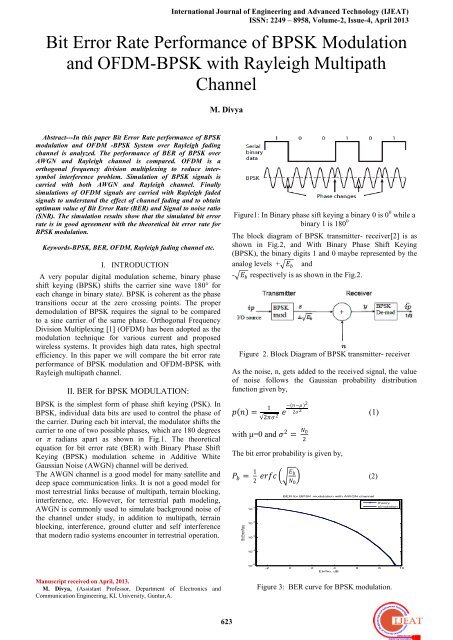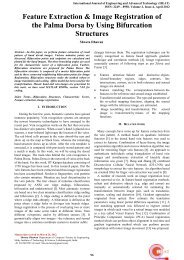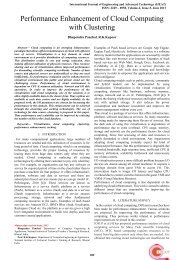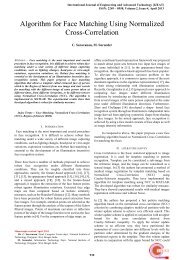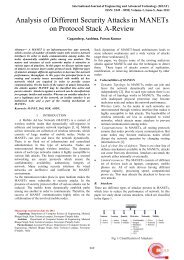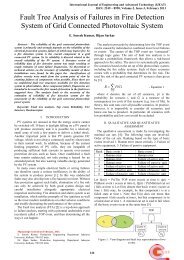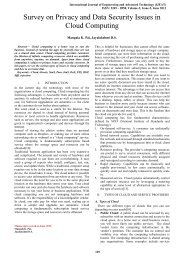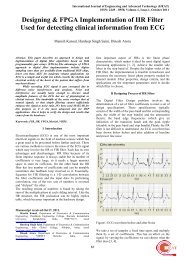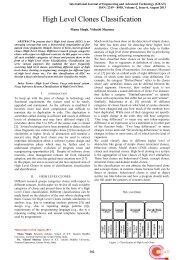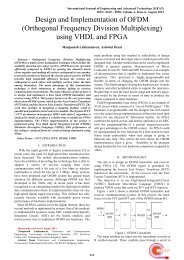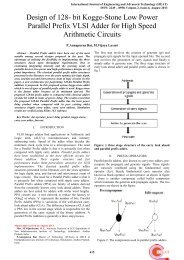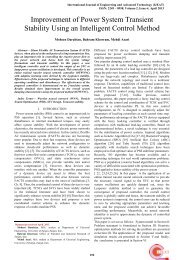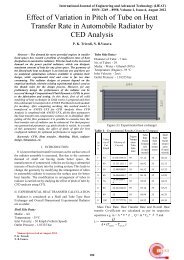Bit Error Rate Performance of BPSK Modulation and OFDM-BPSK ...
Bit Error Rate Performance of BPSK Modulation and OFDM-BPSK ...
Bit Error Rate Performance of BPSK Modulation and OFDM-BPSK ...
Create successful ePaper yourself
Turn your PDF publications into a flip-book with our unique Google optimized e-Paper software.
<strong>Bit</strong> <strong>Error</strong> <strong>Rate</strong><br />
International Journal <strong>of</strong> Engineering <strong>and</strong> Advanced Technology (IJEAT)<br />
ISSN: 2249 – 8958, Volume-2, Issue-4, April 2013<br />
<strong>Bit</strong> <strong>Error</strong> <strong>Rate</strong> <strong>Performance</strong> <strong>of</strong> <strong>BPSK</strong> <strong>Modulation</strong><br />
<strong>and</strong> <strong>OFDM</strong>-<strong>BPSK</strong> with Rayleigh Multipath<br />
Channel<br />
M. Divya<br />
Abstract---In this paper <strong>Bit</strong> <strong>Error</strong> <strong>Rate</strong> performance <strong>of</strong> <strong>BPSK</strong><br />
modulation <strong>and</strong> <strong>OFDM</strong> -<strong>BPSK</strong> System over Rayleigh fading<br />
channel is analyzed. The performance <strong>of</strong> BER <strong>of</strong> <strong>BPSK</strong> over<br />
AWGN <strong>and</strong> Rayleigh channel is compared. <strong>OFDM</strong> is a<br />
orthogonal frequency division multiplexing to reduce intersymbol<br />
interference problem. Simulation <strong>of</strong> <strong>BPSK</strong> signals is<br />
carried with both AWGN <strong>and</strong> Rayleigh channel. Finally<br />
simulations <strong>of</strong> <strong>OFDM</strong> signals are carried with Rayleigh faded<br />
signals to underst<strong>and</strong> the effect <strong>of</strong> channel fading <strong>and</strong> to obtain<br />
optimum value <strong>of</strong> <strong>Bit</strong> <strong>Error</strong> <strong>Rate</strong> (BER) <strong>and</strong> Signal to noise ratio<br />
(SNR). The simulation results show that the simulated bit error<br />
rate is in good agreement with the theoretical bit error rate for<br />
<strong>BPSK</strong> modulation.<br />
Keywords-<strong>BPSK</strong>, BER, <strong>OFDM</strong>, Rayleigh fading channel etc.<br />
I. INTRODUCTION<br />
A very popular digital modulation scheme, binary phase<br />
shift keying (<strong>BPSK</strong>) shifts the carrier sine wave 180° for<br />
each change in binary state). <strong>BPSK</strong> is coherent as the phase<br />
transitions occur at the zero crossing points. The proper<br />
demodulation <strong>of</strong> <strong>BPSK</strong> requires the signal to be compared<br />
to a sine carrier <strong>of</strong> the same phase. Orthogonal Frequency<br />
Division Multiplexing [1] (<strong>OFDM</strong>) has been adopted as the<br />
modulation technique for various current <strong>and</strong> proposed<br />
wireless systems. It provides high data rates, high spectral<br />
efficiency. In this paper we will compare the bit error rate<br />
performance <strong>of</strong> <strong>BPSK</strong> modulation <strong>and</strong> <strong>OFDM</strong>-<strong>BPSK</strong> with<br />
Rayleigh multipath channel.<br />
II. BER for <strong>BPSK</strong> MODULATION:<br />
<strong>BPSK</strong> is the simplest form <strong>of</strong> phase shift keying (PSK). In<br />
<strong>BPSK</strong>, individual data bits are used to control the phase <strong>of</strong><br />
the carrier. During each bit interval, the modulator shifts the<br />
carrier to one <strong>of</strong> two possible phases, which are 180 degrees<br />
or π radians apart as shown in Fig.1. The theoretical<br />
equation for bit error rate (BER) with Binary Phase Shift<br />
Keying (<strong>BPSK</strong>) modulation scheme in Additive White<br />
Gaussian Noise (AWGN) channel will be derived.<br />
The AWGN channel is a good model for many satellite <strong>and</strong><br />
deep space communication links. It is not a good model for<br />
most terrestrial links because <strong>of</strong> multipath, terrain blocking,<br />
interference, etc. However, for terrestrial path modeling,<br />
AWGN is commonly used to simulate background noise <strong>of</strong><br />
the channel under study, in addition to multipath, terrain<br />
blocking, interference, ground clutter <strong>and</strong> self interference<br />
that modern radio systems encounter in terrestrial operation.<br />
Figure1: In Binary phase sift keying a binary 0 is 0 0 while a<br />
binary 1 is 180 0<br />
The block diagram <strong>of</strong> <strong>BPSK</strong> transmitter- receiver[2] is as<br />
shown in Fig.2, <strong>and</strong> With Binary Phase Shift Keying<br />
(<strong>BPSK</strong>), the binary digits 1 <strong>and</strong> 0 maybe represented by the<br />
analog levels + E b <strong>and</strong><br />
- E b respectively is as shown in the Fig.2.<br />
Figure 2. Block Diagram <strong>of</strong> <strong>BPSK</strong> transmitter- receiver<br />
As the noise, n, gets added to the received signal, the value<br />
<strong>of</strong> noise follows the Gaussian probability distribution<br />
function given by,<br />
p n = 1<br />
−μ )2<br />
e−(n2σ 2 (1)<br />
2πσ 2<br />
with μ=0 <strong>and</strong> σ 2 = N 0<br />
2<br />
The bit error probability is given by,<br />
P b = 1 2 erfc<br />
10 -2<br />
10 -3<br />
E b<br />
N 0<br />
(2)<br />
BER for <strong>BPSK</strong> modulation with AWGN channel<br />
theory<br />
simulation<br />
10 -1 Eb/No, dB<br />
10 -4<br />
10 -5<br />
-2 0 2 4 6 8 10<br />
Manuscript received on April, 2013.<br />
M. Divya, (Assistant Pr<strong>of</strong>essor, Department <strong>of</strong> Electronics <strong>and</strong><br />
Communication Engineering, KL University, Guntur,A.<br />
Figure 3: BER curve for <strong>BPSK</strong> modulation.<br />
623
<strong>Bit</strong> <strong>Error</strong> <strong>Rate</strong><br />
<strong>Bit</strong> <strong>Error</strong> <strong>Rate</strong> <strong>Performance</strong> <strong>of</strong> <strong>BPSK</strong> <strong>Modulation</strong> <strong>and</strong> <strong>OFDM</strong>-<strong>BPSK</strong> with Rayleigh Multipath Channel<br />
A. Rayleigh Fading Model:<br />
In a multipath environment, it is reasonably intuitive to<br />
visualize that an impulse transmitted from transmitter will<br />
reach the receiver as a train <strong>of</strong> impulses. The Multipath<br />
Rayleigh Fading Channel implements a baseb<strong>and</strong> simulation<br />
<strong>of</strong> a multipath Rayleigh fading propagation channel[3]-[4].<br />
This channel is useful for modeling mobile wireless<br />
communication systems.<br />
Relative motion between the transmitter <strong>and</strong> receiver<br />
causes Doppler shifts in the signal frequency. The Jakes<br />
PSD (power spectral density) determines the spectrum <strong>of</strong><br />
the Rayleigh process. Since a multipath channel reflects<br />
signals at multiple places, a transmitted signal travels to the<br />
receiver along several paths that may have different lengths<br />
<strong>and</strong> hence different associated time delays. Fading occurs<br />
when signals traveling along different paths interfere with<br />
each other.<br />
Figure 4: Impulse response <strong>of</strong> a multipath channel<br />
Let the transmit b<strong>and</strong> pass signal be<br />
x t = R x b t e j2πf ct<br />
(3)<br />
Where<br />
x b t is the base b<strong>and</strong> signal<br />
f c is the carrier frequency<br />
t is the time<br />
As shown above, the transmit signal reaches the receiver<br />
through multiple paths where the n th path has an attenuation<br />
α n (t) <strong>and</strong> delay Γ n (t). The received signal is,<br />
A circularly symmetric complex r<strong>and</strong>om variable Z, which<br />
is a combination <strong>of</strong> real <strong>and</strong> imaginary parts,<br />
E Z = E e jθ Z = e jθ E Z (8)<br />
A circularly symmetric complex Gaussian r<strong>and</strong>om variable<br />
is completely specified by the variance,<br />
σ 2 = E[Z 2 ] (9)<br />
The Rayleigh r<strong>and</strong>om variable which is nothing but<br />
probability density function is given by,<br />
p Z = z<br />
σ 2 e−z2 2σ 2 , z≥0 (10)<br />
In order to get the bit error rate for <strong>BPSK</strong> with Rayleigh<br />
fading channel which is <strong>of</strong> the form y= zx+n, assume that<br />
the channel is flat fading <strong>and</strong> is r<strong>and</strong>omly varying in time.<br />
The noise, n has the Gaussian probability density function<br />
which is given by equation (1) i.e; p n = 1 −μ )2<br />
e−(n2σ 2<br />
2σ2 Equation (2) gives the <strong>Bit</strong> error probability, however the<br />
presence <strong>of</strong> channel z, the effective bit energy to noise ratio<br />
is z 2 E b<br />
. so the bit error rate probability for a given value<br />
N 0<br />
<strong>of</strong> z is given by,<br />
P b z = 1 2 erfc<br />
z 2 E b<br />
= 1 erfc ᵧ ( 11)<br />
N 0 2<br />
Where ᵧ = z 2 E b<br />
. So the error probability is given by,<br />
N 0<br />
P b = 1 2<br />
1 −<br />
E b<br />
N0<br />
E b<br />
N0 +1<br />
(12)<br />
From above equation we can draw the bit error rate curve<br />
for <strong>BPSK</strong> using Rayleigh channel.<br />
BER for <strong>BPSK</strong> modulation in RAYLEIGH channel<br />
r t =<br />
n<br />
α n t x[t − Γ n (t)] (4)<br />
AWGN-Theory<br />
Rayleigh-Theory<br />
Rayleigh-Simulation<br />
10 -1 Eb/No, dB<br />
Plugging in the equation for transmit baseb<strong>and</strong> signal from<br />
the above equation,<br />
10 -2<br />
r t = R<br />
n<br />
α n t x b [t − Γ n t ]e j2πf c t−Γ n t<br />
(5)<br />
10 -3<br />
10 -4<br />
The baseb<strong>and</strong> equivalent <strong>of</strong> the received signal is,<br />
r b t =<br />
n<br />
α n t e −j2πf cΓ n t<br />
x b t − Γ n t<br />
= α n (t)e −jθ n (t)<br />
n x b [t − Γ n t ] (6)<br />
Where θ n t = 2πf c Γ n (t) is the phase <strong>of</strong> the n th path. The<br />
impulse response is,<br />
b (t) = α n (t)e −jθ n (t)<br />
n (7)<br />
10 -5<br />
0 5 10 15 20 25 30 35<br />
Figure 5: Comparision between AWGN <strong>and</strong> Rayleigh<br />
channel BER for <strong>BPSK</strong><br />
III. ORTHOGONAL FREQUENCY DIVISION<br />
MULTIPLEXING (<strong>OFDM</strong>)<br />
Orthogonal frequency division multiplexing (<strong>OFDM</strong>)<br />
combines modulation <strong>and</strong> multiplexing techniques to<br />
624
International Journal <strong>of</strong> Engineering <strong>and</strong> Advanced Technology (IJEAT)<br />
ISSN: 2249 – 8958, Volume-2, Issue-4, April 2013<br />
improve spectral efficiency. A transmission channel is<br />
divided into many smaller sub channels or subcarriers. The<br />
subcarrier frequencies <strong>and</strong> spacing are chosen so they are<br />
orthogonal to one another. Their spectra won’t interfere with<br />
one another, then, so no guard b<strong>and</strong>s are required.<br />
Most broadb<strong>and</strong> systems are subject to multipath<br />
transmission. Conventional solution to multipath is<br />
equalizer in the receiver but for high data rates equalizers<br />
are too complicated. With <strong>OFDM</strong> there is a simple way <strong>of</strong><br />
dealing with multipath which makes use <strong>of</strong> relatively simple<br />
DSP algorithms. <strong>OFDM</strong> solves the problem <strong>of</strong> multipath by<br />
transmitting the data in parallel with longer symbol period<br />
<strong>and</strong> by cyclic prefix to reduce Inter Symbol Interference [5].<br />
In <strong>OFDM</strong> parallel data streams are used as inputs to an<br />
IFFT. IFFT output is sum <strong>of</strong> signal samples. IFFT does<br />
modulation <strong>and</strong> multiplexing in one step. Filtering <strong>and</strong> D/A<br />
<strong>of</strong> samples results in baseb<strong>and</strong> signal as shown in Fig. 6<br />
Figure 8: Effect <strong>of</strong> multipath on symbol with cyclic prefix<br />
Figure 9: Frequency selective fading<br />
Let us use an <strong>OFDM</strong> system based on IEEE 802.11a<br />
specifications which are shown in Table. 1.<br />
Parameter<br />
Value<br />
FFT size. nFFT 64<br />
Number <strong>of</strong> used subcarriers. nDSC 52<br />
Figure 6: Baseb<strong>and</strong> <strong>OFDM</strong> system.<br />
FFT Sampling frequency<br />
20MHz<br />
A. BER <strong>of</strong> <strong>OFDM</strong>-<strong>BPSK</strong>:<br />
The total channel is a frequency selective channel [3]-<br />
[8], the channel experienced by each subcarrier in an <strong>OFDM</strong><br />
system is a flat fading channel with each subcarrier<br />
experiencing independent Rayleigh fading. So, assuming<br />
that the number <strong>of</strong> taps in the channel is lower than the<br />
cyclic prefix as shown in Figure. 7 duration (which ensures<br />
that there is no inter symbol interference), the BER for<br />
<strong>BPSK</strong> with <strong>OFDM</strong> in a Rayleigh fading channel should be<br />
same as the result obtained for BER for <strong>BPSK</strong> in Rayleigh<br />
fading channel.<br />
To eliminate ICI, the <strong>OFDM</strong> symbol is cyclically<br />
extended in the guard interval. The cyclic prefix is actually<br />
a copy <strong>of</strong> the last portion <strong>of</strong> the data symbol appended to the<br />
front <strong>of</strong> the symbol during the guard interval.<br />
Figure 7: Cyclic prefix<br />
Subcarrier spacing<br />
Used subcarrier index<br />
Cyclic prefix duration, Tcp<br />
Data symbol duration, Td<br />
Total Symbol duration, Ts<br />
Table 1: specifications <strong>of</strong> <strong>OFDM</strong> system<br />
312.5kHz<br />
{-26 to -1, +1 to<br />
+26}<br />
0.8us<br />
3.2us<br />
4us<br />
The relation between symbol energy <strong>and</strong> the bit energy is<br />
given by,<br />
E s<br />
= E b nDSC T d<br />
(12)<br />
N 0 N 0 nFFT T d + T cp<br />
Expressing in decibels,<br />
E s<br />
dB = N 0<br />
E b<br />
dB + 10log nDSC<br />
N 10 +<br />
0 nFFT<br />
10log 10<br />
T d<br />
T d +T cp<br />
(13)<br />
The bit error rate for <strong>BPSK</strong> with Rayleigh channel [9]-<br />
[10] is same as that <strong>of</strong> Equation (12). Simulation results for<br />
bit error rate <strong>of</strong> <strong>BPSK</strong> with <strong>OFDM</strong> with AWGN <strong>and</strong><br />
625
BER<br />
BER<br />
<strong>Bit</strong> <strong>Error</strong> <strong>Rate</strong> <strong>Performance</strong> <strong>of</strong> <strong>BPSK</strong> <strong>Modulation</strong> <strong>and</strong> <strong>OFDM</strong>-<strong>BPSK</strong> with Rayleigh Multipath Channel<br />
Rayleigh channel are as shown in figure.10<strong>and</strong><br />
figure.11respectively.<br />
10 -2<br />
10 -3<br />
<strong>Bit</strong> error probability curve for <strong>BPSK</strong> using <strong>OFDM</strong> with AWGN channel<br />
simulation<br />
Theoritical<br />
Wireless Persona Communications: An International<br />
Journal archive, Volume 30, Issue 1, July 2004.<br />
[8]. Ismail. M.H., MS Matalgah, Mustafa M, BER analysis <strong>of</strong><br />
bpsk modulation over the weibull fading channel with cci,<br />
Vehicular Technology Conference, 2006. VTC- 2006 Fall,<br />
2006, IEEE 64 th.<br />
[9]. Aalo VA, Piboongungon T <strong>and</strong> C D Isk<strong>and</strong>er , <strong>Bit</strong>-error rate <strong>of</strong><br />
binary digital modulation schemes in generalized gamma<br />
fading channels, IEEE Communication Letters, Vol. 09,<br />
No. 2, pp 139–141, Feb. 2005.<br />
[10]. M.X.Chang <strong>and</strong> Yu T.Su ,” <strong>Performance</strong> analysis <strong>of</strong> Equalized<br />
<strong>OFDM</strong> systems in Rayleigh fading” IEEE Trans. On wireless<br />
comm. Vol. 1 no.4. pp.721- 732.oct2002.<br />
10 -1 EbNo<br />
10 -4<br />
10 -5<br />
0 2 4 6 8 10 12<br />
Figure 10: BER curve for <strong>OFDM</strong>-<strong>BPSK</strong> with<br />
AWGN channel<br />
<strong>Bit</strong> error probability curve for <strong>BPSK</strong> using <strong>OFDM</strong><br />
10 0<br />
10 -1<br />
Eb/No<br />
simulated<br />
theoritical<br />
10 -2<br />
10 -3<br />
10 -4<br />
10 -5<br />
0 5 10 15 20 25 30 35 40<br />
Figure 11: BER curve for <strong>OFDM</strong>-<strong>BPSK</strong> with<br />
Rayleigh Channel<br />
IV. CONCLUSION<br />
In this paper, the performance <strong>of</strong> <strong>BPSK</strong> with <strong>OFDM</strong><br />
AWGN <strong>and</strong> Rayleigh fading distribution was evaluated.<br />
Graphical results show the improvement in <strong>BPSK</strong> with<br />
Rayleigh fading channel compared to its performance in<br />
AWGN channel. The graphical results prove that simulated<br />
BER <strong>of</strong> <strong>BPSK</strong> is same as that <strong>of</strong> theoretical BER <strong>of</strong> <strong>BPSK</strong>.<br />
The reported BER can be further reduced by using channel<br />
estimation or suitable diversity scheme.<br />
REFERENCES<br />
[1]. Sood Neetu, Ajay K Sharma, Uddin Moin, BER performance <strong>of</strong><br />
<strong>OFDM</strong>-<strong>BPSK</strong> <strong>and</strong> QPSK over Generalized Gamma Fading<br />
Channel, International Journal <strong>of</strong> Computer Applications (0975 –<br />
8887), Volume 3 – No.6, June 2010.<br />
[2]. Simon Haykin, Communication Systems, John Wiley & Sons, Inc.,<br />
3rd edition, 1994.<br />
[3]. Lei Wan, V. K. Dubey, ―<strong>Bit</strong> error probability <strong>of</strong> <strong>OFDM</strong> system<br />
over frequency nonselective fast Rayleigh fading channels, IEEE<br />
Electronics letters, Vo. 36, No. 15, pp1306-1307, July 2000.<br />
[4]. Yong Jae Ryu , Dong seong Han, ―Timing phase estimator<br />
overcoming rayleigh fading for <strong>OFDM</strong> systems, IEEE Proc., pp.<br />
66-67, 2001<br />
[5]. Moose P., "A Technique for Orthogonal Frequency Division<br />
Multiplexing Frequency Offset Correction", IEEE Transactions<br />
on Communications, Vol. 42, No. 10, pp 2908- 2914, October<br />
1994.<br />
[6]. Dr.S.S.Riaz Ahamed, <strong>Performance</strong> analysis <strong>of</strong> <strong>of</strong>dm, Journal <strong>of</strong><br />
Theoretical <strong>and</strong> Applied Information Technology,2008 JATIT.<br />
[7]. Chien-HungChen, Chien-ChingChiu, Shi- Cheng Hung, Chien-<br />
Hung Lin, BER <strong>Performance</strong> <strong>of</strong> Wireless <strong>BPSK</strong><br />
Communication System in Tunnels With <strong>and</strong> Without Traffic,<br />
626


